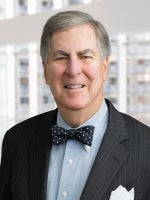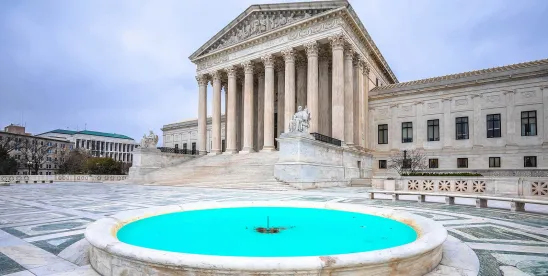If the wide-ranging decisions that ended the U.S. Supreme Court’s 2024 term on Friday have anything in common, it is their length, with some of their syllabi running to five small-print pages and more, and with a plethora of concurring and dissenting opinions.
As one might expect, these concluding decisions are the most controversial and perhaps far-reaching of the term, and hence were the most difficult for the Justices to resolve until the end. The easier ones brought unanimity, or near to it. These final decisions don’t come close.
Trump v. CASA
Most Americans have little, if any, knowledge of or interest in the kind of injunctive relief that might be available for a court to appropriately limit allegedly improper conduct or preserve the status quo while a final decision is pending. Those of us who litigate cases that involve issues of nationwide scope and effect, however, are very interested in the scope of injunctive relief our clients either see or oppose.
Unexpectedly to many, but not to those who listened closely to the oral argument in the case, the Supreme Court started its last day of the term with what may prove a highly controversial opinion that ducked the substantive issue presented and jumped to a holding essentially banning “universal injunctions,” that is, injunctions that extend to individuals beyond those immediately before the court, often nationwide.
In Trump v. CASA, various individuals, organizations, and states brought several cases seeking to enjoin actions taken to enforce President Trump’s executive order titled “Protecting the Meaning and Value of American Citizenship.” The executive order cites conditions where a person who was born in the United States is not “subject to the jurisdiction thereof” and thus is not an American citizen. The plaintiffs, who are the respondents in the Supreme Court, alleged that the executive order violates the Fourteenth Amendment’s Citizenship Clause and §201 of the Nationality Act of 1940.
In each case, the district court “entered a ‘universal injunction’—an injunction barring executive officials from applying the Executive Order to anyone, not just the plaintiffs. And in each case, the Court of Appeals denied the Government’s request to stay the sweeping relief.” The government argued that the lower courts lacked equitable authority to impose universal relief.
Because these applications for stays of injunctive relief did not raise the question of whether the executive order violated the Citizenship Clause or Nationality Act, the Supreme Court avoided the substantive claim and only addressed whether, under the Judiciary Act of 1789, federal courts have equitable authority to issue universal injunctions. Although the Court did so in the context of ruling on a stay, ostensibly dealing with the issue of likelihood of success on the merits, Justice Barrett’s opinion for a six-Justice majority left no question about what the district courts are required to do with respect to injunctive relief itself.
Noting that the issue of expansive injunctive relief has been presented to the Court on multiple occasions without resolution, and that the number of universal injunctions has steadily increased over the years, the Court decided to take the issue head-on. While the Court’s decision was lengthy, it can be summarized succinctly: “The issuance of a universal injunction can be justified only as an exercise of equitable authority, yet Congress has granted federal courts no such power” through the Judiciary Act of 1789 or otherwise. Barrett ultimately wrote that “federal courts do not exercise general oversight of the Executive Branch; they resolve cases and controversies consistent with the authority Congress has given them. When a court concludes that the Executive Branch has acted unlawfully, the answer is not for the court to exceed its power, too.”
The Court thus granted the government’s applications to stay the preliminary injunctions that had been granted below, “but only to the extent that the injunctions are broader than necessary to provide complete relief to each plaintiff with standing to sue.” The injunctions were also stayed to the extent that they prohibited executive agencies from issuing guidance about the implementation of the executive order on citizenship.
Justice Sotomayor’s dissent focused on the merits claim that the Court avoided, arguing, for the liberal Justices, that the question of birthright citizenship has long been settled and that the Court is using a procedural deception to justify not ruling on it here.
Despite the categorical opinion of the Court concerning universal injunctions, Justice Alito’s concurring opinion, and, to some extent, the concurrence of Justice Kavanaugh, suggested what I believe is a reasonable concern about what is left open to plaintiffs and the courts with respect to broad injunctive relief. Justice Alito wrote separately to take note of “two related issues that are left unresolved and potentially threaten the practical significance of today’s decision: the availability of third-party standing and class certification.” I respectfully suggest that he is correct, though many others will be happier about it than he will.
Both of these questions are left open, and each offers the possibility of expansive relief, notwithstanding Trump v. CASA, albeit adding complexity and expense to matters challenging governmental action. I submit that certain state attorneys general, for example, will be prepared to bring cases as third parties nominally supporting the citizens of their states, seeking relief for individuals beyond those who might be named plaintiffs. Even more likely, I suggest, will be plaintiffs who, with associational support, bring class actions seeking just the sort of nationwide relief that was held unavailable in the context of Friday’s case. So, the story of broad injunctive relief is likely not over. There are some anti-climactic chapters to be added.
Kennedy v. Braidwood Management, Inc.
Most medical organizations and their practitioners, along with the many health care attorneys who represent them and, of course, their patients, have eagerly awaited the Court’s decision in Kennedy v. Braidwood Management, Inc. In the immediate sense, these interested parties will likely be very satisfied with the Court’s 6–3 opinion upholding the appointment and authority of a panel, created under the Affordable Care Act, to require insurers to cover preventive care treatments, including prescriptions for cancer screenings, HIV-prevention drugs, and statins to deal with heart disease. The majority opinion of the Court—playing against stereotypes—was written by Justice Kavanaugh, who was joined by the Chief Justice and Justice Barrett, along with the Court’s three liberals.
The case began with a suit brought by several Texas small businesses and others, who asserted that the panel’s recommendation that pre-exposure prophylaxis (also known as “PrEP”), medicine be included as a mandatory preventive care service violated their religious beliefs by encouraging homosexual activities, intravenous drug use, and sex outside of marriage. But their legal claim, and the one considered and rejected by the Supreme Court, was that the preventive care coverage mandates were unconstitutional because, under the Appointments Clause of the Constitution, the task force members are “inferior officers” who aren’t appointed by the President or confirmed by the Senate. However, inferior officers appointed by the Secretary of Health and Human Services (HHS) were consistent with the Constitution. As the Court summarized:
The Appointments Clause in Article II specifies how “Officers of the United States” must be appointed, dividing all officers into two classes. Principal officers must be appointed by the President “with the Advice and Consent of the Senate.” Inferior officers likewise may be appointed by Presidential nomination and Senate confirmation, but Congress may also “by Law vest” their appointment “in the President alone, in the Courts of Law, or in the Heads of Departments.” Art. II, §2, cl. 2. Principal officers encompass at least department heads who report directly to the President. Inferior officers are those “whose work is directed and supervised at some level by others who were appointed by Presidential nomination with the advice and consent of the Senate.” . . . Task Force members are inferior officers because their work is directed and supervised” by the Secretary of HHS, a principal officer, through two main sources of authority.
That two-part authority provides a “powerful tool for control.” The HHS Secretary may remove such officers at will, a feature that creates “here-and-now subservience.” “Beyond at-will removal, the Secretary has statutory authority to directly review and block task force recommendations before they take effect.” In sum, because their work is “directed and supervised” by the HHS Secretary, task force members do not need to be confirmed by the Senate. Their independence is not a reference to their supervision, but rather to being free of influence by regulated outside parties.
The task force members in question were appointees of President Biden. It might be surprising that the Trump administration supported the Biden appointees. However, in siding with the Trump administration, which defended the HHS Secretary, the Supreme Court reinforced the ability of Secretary Robert F. Kennedy Jr. to exert control not just over this panel, but others as well. Indeed, Kennedy has recently exercised this dismissal power under circumstances in which he and the administration are likely to be challenged as to certain health care agency actions.
Federal Communications Commission v. Consumers’ Research
Federal Communications Commission v. Consumers’ Research might seem to some to be a throwback, involving the non-delegation cases of the 1930s. The Communications Act of 1934 instructs the Federal Communications Commission (FCC) to make available to “all the people of the United States” reliable communications services “at reasonable charges.” That construct is now known as “universal service.” In 1996, Congress amended the law to require every carrier providing interstate telecommunications services to “contribute” to a fund, the proceeds of which must be used to support universal subsidy programs for low-income consumers, those in rural areas, schools and libraries, and rural hospitals. The amended law also provides detailed guidance as to the communications services to which those beneficiaries should have access. In selecting services to be subsidized, “the FCC ‘shall consider the extent to which’ a service is ‘essential to education. . . .’”
In another 6–3 decision, this time with Justice Kagan writing for herself, the Chief Justice, and Justices Sotomayor, Kavanaugh, Barrett, and Jackson, the Court held that the universal-service contribution scheme does not violate the non-delegation doctrine. While the remaining three “conservatives” dissented, it was interesting to see that not only the Chief Justice but also Justices Kavanaugh and Barrett were in unison with the three “liberals” in this case. I note that this outcome could be taken to reflect, as I’ve discussed in the past, an affinity between Justice Kagan and Justice Kavanaugh in administrative law matters, as well as the independence of Justice Barrett more generally.
As the Court explained, while Article I of the Constitution assigns all legislative powers to Congress and bars further delegation, Congress may seek assistance from, and vest discretion in, executive agencies to implement the laws it has enacted. To ascertain what is permissible and what is not, the “Court asks whether Congress has set out an ‘intelligible principle’ to guide what it has given the agency to do. . . . Under that test, Congress must make clear both ‘the general policy’ the agency must pursue and ‘the boundaries of [its] delegated authority.’” Here, the Court rejects applying an alternative tax-based test and upholds the universal-service regime.
Mahmoud v. Taylor
The 6–3 split between conservatives and liberals in Mahmoud v. Taylor reflected divisive and ongoing cultural debates in the larger society. Confining ourselves simply to the situation at bar, we find that during the 2022–2023 school year, the Montgomery County, Maryland, Board of Education (the “Board”) introduced a variety of “LGBTQ+-inclusive” texts into the public school curriculum. When parents in Montgomery County sought to have their children excused from instruction involving those books, the Board initially permitted it.
Later, however, the Board rescinded this opt-out policy because, inter alia, the significant number of opt-outs was disrupting the classroom environment. A group of parents from diverse religious groups holding sincere views on sexuality and gender that they wish to instill in their children brought suit, claiming that the Board’s no-opt-out policy infringed on the parents’ right to the free exercise of their religion and seeking a preliminary injunction.
Writing for the majority, Justice Alito opined that the parents were likely to succeed on their claim that the Board’s policies unconstitutionally burden their religious exercise. He states that the Court has “long recognized the rights of parents to direct ‘the religious upbringing’ of their children. . . . Those rights are violated by government policies that ‘substantially interfer[e] with the religious development’ of children.” Accordingly, the Court held that an injunction here would be both equitable and in the public interest and that it should require the Board “to notify the petitioners in advance whenever one of the books in question or any other similar book is to be used in any way and to allow them to have their children excused from that instruction.”
Justice Sotomayor’s dissent claimed that the majority’s holding impermissibly interferes with exposing students to new ideas, a function that always has been a vital part of the educational process. Sotomayor attached illustrated excerpts from the books at issue, which allow someone to see what is being taught and make an individual assessment as to their message and effect.
Free Speech Coalition v. Paxton
Free Speech Coalition v. Paxton was another case involving the First Amendment and children with respect to sexually oriented materials far more explicit than those in the previous case. Texas, among other states, prohibits distributing sexually explicit content to children. A 2023 Texas statute requires certain websites publishing sexually explicit or obscene content to verify that visitors are aged 18 or older, or else face injunctions and civil penalties.
The petitioners, representatives of the pornography industry, sued to enjoin enforcement of the statute as facially unconstitutional under the First Amendment’s Free Speech Clause. Because in order to confine access to adults, the law requires visitors to “comply with a commercial age verification system” that uses “government-issued identification” or “a commercially reasonable method that relies on public or private transactional data,” these petitioners claimed that the statute impermissibly hinders adults who have a right to access the covered “speech.”
The U.S. Court of Appeals for the Fifth Circuit held against an injunction and determined that the law was not subject to any heightened scrutiny under the First Amendment. The Supreme Court agreed, holding that the statute “triggers, and survives, review under intermediate scrutiny because it only incidentally burdens the protected speech of adults.”
To determine whether a law that regulates speech violates the First Amendment, the Court will consider the nature of the burden imposed and the nature of the speech. While a law that targets protected speech “based on its communicative content” is presumptively vulnerable, that was not the case here. This particular statute “has only an incidental effect on protected speech,” and is therefore subject to intermediate scrutiny. “The First Amendment leaves undisturbed States’ traditional power to prevent minors from accessing speech that is obscene from their perspective. That power includes the power to require proof of age before an individual can access such speech. It follows that no person—adult or child—has a First Amendment right to access such speech without first submitting proof of age.”
Justice Thomas wrote for the Court, over the dissent of Justices Kagan, Sotomayor, and Jackson. The dissenters did not disagree that it was appropriate to keep pornographic materials away from children, but argued that the burden on adults here could not survive heightened scrutiny.
I did say at the beginning of this post that the Court’s term has ended. As far as the delivery of formal opinions, that is true. However, as a caveat, the so-called “shadow docket,” i.e., the cases that come to the Court via emergency and other motions, will likely remain open for business. Given the administration’s recent record of controversial executive orders, it would not be surprising if you hear from me again before October.
For now, I’ll sign off with thanks to my many readers for their attention and interest, especially for those of you who have commented on these posts, mostly in favorable terms and always with civility.




 />i
/>i

